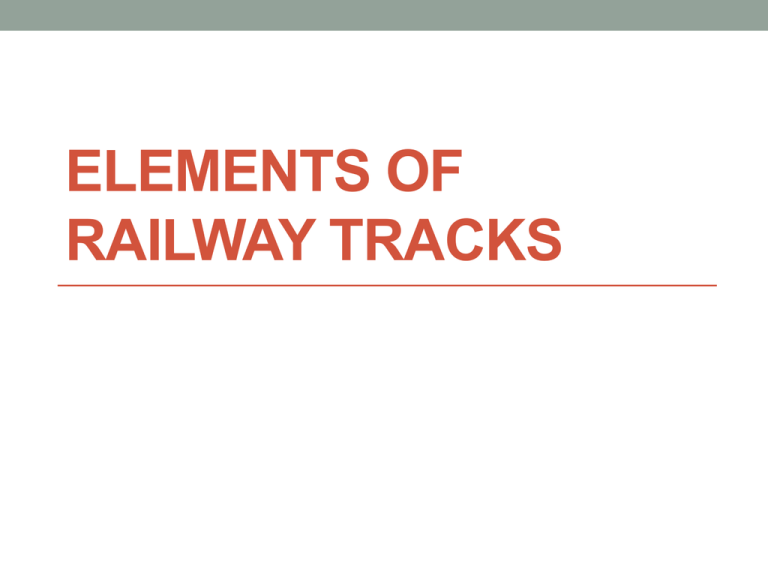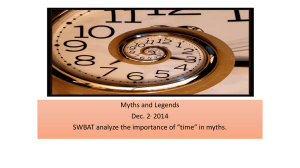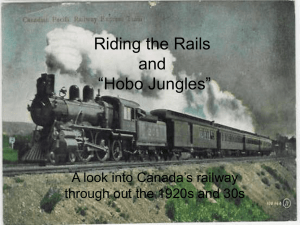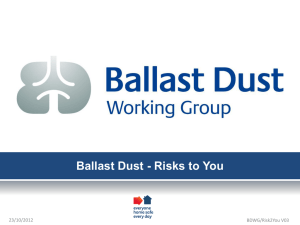ELEMENTS OF RAILWAY TRACKS - wec civilians
advertisement

ELEMENTS OF RAILWAY TRACKS ELEMENTS OF RAILWAY TRACKS A railway track is a combination of 1. Formation 2. Ballast 3. Sleepers 4. Rails 5. Fastenings 1. FORMATION • The surface prepared to receive the ballast, sleepers, rails, etc.. for constructing the railway track is called formation or sub grade. Function of formation The formation has the following functions • It provides a smooth and uniform bed on which the track is laid. • It bears the entire load transmitted from the moving loads to it through the ballast. • It provides drainage facilities. • It provides stability to the track. Design aspects WIDTH The width of the formation depends upon • Numbers of tracks to be laid over it. • Gauge of the track. • Width of ballast layer. • Width of drains provided. HEIGHT The height of the formation depends upon the topography of the alignment and the gradients adopted. SLIDE SLOPES The slide slopes of the formation depends upon the characteristics of the soil, as shear strength, angle of repose etc. 2. BALLAST Ballast is a layer of broken stone, gravel, or any other suitable material placed under and around the sleepers for distributing the load from the sleepers to the formation Functions of Ballast • It provides a suitable foundation for the sleepers. • It transfer and distributes loads from the sleepers to a larger area of formation. • it provides effective drainage to the track. • It helps in protecting the top surface of the formation. Physical Properties of Good Ballast • It should be hard and tough. • It should wear resistant and durable. • It should be non-porous and non-absorbent of water. • It should be cheaper and easily available. • It should not be brittle. • It should not allow rain water to accumulate Types of ballast Following materials can be used as ballast: 1. Broken stone • • • It is the best material to be used as ballast. Generally on all important tracks broken stone ballast has been used. Blast of Igneous rocks is the most suitable 2. Gravel • • • It stands second in suitability as ballast. Used in large quantities in many countries. It is obtained from river beds 3. Cinders or Ashes • The residue obtained from the coal used in locomotives is known as Cinder or Ash. 4. Sand • • It stands fourth in merits as ballast material. Coarse sand is better than fine sand. 5. Brick ballast • Where stone or other suitable ballast is not available, over burnt brick ballast can be used. 6. Kankar • • It is found in the form of particles of varying sizes. Where stone is not easily and at reasonable price available, kankar can be used as road metal and ballast for railway tracks. 3. SLEEPERS Sleeper is transverse support for a railway to give stiffness to it. Functions of sleepers • Holds the rails to correct gauge. • Give a firm and even support to the rails. • Distributes the axle load over a sufficiently large area of ballast. • To act as elastic medium between the rails and ballast to absorb vibration. • To maintain the alignment of the track. • To provide insulation for electrified track. Classification of sleepers Depending on the material used for their manufacture, the sleepers can be divided into the following categories • Wooden sleepers. • Steel sleepers. • Cast iron sleepers. • Concrete sleepers WOODEN SLEEPERS • Wooden sleepers are the ideal type of sleeper. Hence they are universally used. The utility of timber sleepers has not diminished due to the passage of time. ADVANTAGES Wooden sleepers have the following advantages: • They are easy to manufacture • They are more useful for heavy loads and high speeds • They are easy to handle without damage • They are more suitable for soft formations • They absorb shocks and vibrations better than other types of sleepers. DISADVANTAGES • They are easily liable to attack by vermin and weather. Hence their life is lesser than other type of sleepers • They are susceptible to fire. • Their maintenance cost is highest in comparison to other type of sleepers • Their useful life is short about 12 to 15 years. STEEL SLEEPERS • Due to the increasing shortage of timber in the country and other economical factors have led to the use of steel and concrete sleepers on railways. ADVANTAGES • It is more durable. Its life is about 35 years • Lesser damage during handling and transport • Easy to manufacture • It is not susceptible to vermin attack • It is not susceptible to fire • Its scrap value is very good DISADVANTAGES • It is liable to corrosion. • Cracks at rail seats develop during the service. • Fittings required are greater in number. CONCRETE SLEEPERS • Concrete ties have become more common mainly due to greater economy and Shortage of timber. ADVANTAGES • It is more durable having greater life. • It is economical as compare to wood and Steel. • Easy to manufacture. • It is not susceptible to vermin attack • It is not susceptible to fire DISADVANTAGES • It is brittle and cracks without warning. • It cannot be repaired, and required replacement. • Fittings required are greater in number. 4. RAILS Definition and Function • Rail is an iron beam. • Its main function is to provide a most economical, smooth and level surface for the smooth passage of heavily loaded vehicles at great speed. • The two rails of the track also serve as a lateral guide for the running of the wheels. Classification Rails can be classified into the following categories: • Double headed rail • Bull headed rail • Flat footed rail DOUBLE HEADED RAIL • It is of I section or Dumb-bell section. • Such rails have to be supported in chairs which rest on sleepers. • The idea was that when the head of the rail was worn out during the period of service, the rail could be inverted. Later it was found that during the service the bottom table of the rail was dented by the long and continuous contact with the chair to such an extent that it was impossible to reuse it. Hence it was rejected and other types of rail were searched. BULL HEAD RAIL • It is similar in shape to double headed rail with only difference that in bull headed rail more metal is added to the head to allow the greater wear and tear. • The lower head or table was kept of just sufficient size to be able to withstand the stresses to be induced by moving loads. • This rail also required chairs for fixing it to the sleepers. FLAT FOOTED RAIL • It is in inverted T-shaped rail. • Having greater stability. • It was developed by charles Vignoles in 1836 Fastenings The devices used to connect rails and sleepers together to form the track are known as fastenings. These includes: • Fish plates • Bolts • Chairs • Keys • Bearing plates FISH PLATES • The function of a fish plate is to hold two rails together. • At each, joint a pair of fish plates is used. Fish Plate BOLTS Various types of bolts are used in railroad fitting. Some common types are enumerated below. • Fish bolts: • With each pair of fish plates two, four or six fish bolts are used. • The standard practice is to use four bolts. • They are made up of high carbon steel to with stand considerable stresses. • Dogspikes: • Dogspikes are used for holding the rail to the wooden sleepers. • The spike has smooth sites and depends for its holding power on the friction of wood fiber. • Skrewspikes: • Skrewspikes are used for the same purpose as dogspikes • But have a much greater holding power than dogspikes approximately double that of dogspikes. • Roundspikes: • Roundspikes are used for fixing chairs to the wooden sleepers. • Fangbolts: • They have the same purpose as roundspikes. • Have greater strength as compared to roundspikes as they have threads and also grip the sleeper from the Bottom CHAIRS • Chairs are used to hold the double headed and bull headed rails in position. Invariably chairs are made of cast iron and they help in distributing the load from rails to sleepers. KEYS • They are generally wedge shaped wooden pieces or metal pieces. They keep the rail in proper position. • Wooden keys are cheaper, but liable to be attacked by vermin. Hence a number of metal keys have been devised. Key BEARING PLATES • Chair used for flat footed rails are known as bearing plates. • They increase the bearing area on the sleeper and thus decrease the loadingintensity.








